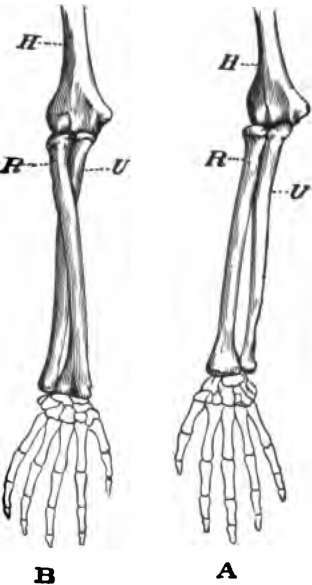Pivot Joints
Description
This section is from the book "The Human Body: An Elementary Text-Book Of Anatomy, Physiology, And Hygiene", by H. Newell Martin. Also available from Amazon: The Human Body.
Pivot Joints
In this form one bone rotates about another. A good example is found between the first and second cervical vertebrę (Figs. 13,14). The odontoid process of the axis reaches up into the neural arch of the atlas, and, kept in place there by the transverse ligament which does not let it press against the spinal cord, forms a pivot around which the atlas rotates, carrying the skull with it when we turn the head to right or left.
A more complicated kind of pivot-joint is found in the forearm. Lay the forearm and hand flat on a table, palm uppermost; without moving the shoulder-joint at all the hand can then be turned over so that its back is upward. In this movement the radius, which carries the hand, crosses over the ulna. When the palm is turned up (supination) the radius and ulna are parallel (Fig. 27, A), and the radius on the outside; place a finger of the other hand on it near the wrist, and then turn the hand over ; the lower end of the radius will be found to cross over the ulna and to be on its inner side (Fig. 27, B), when the movement is completed; in this position the hand is said to bo in pronation.
Is the joint of the lower jaw with the skull a perfect hinge joint? What movements can take place at it?
What is a pivot-joint? Name an instance from the spinal column. Describe the joint between atlas and axis. What happens to the head when the atlas rotates on the odontoid process of the axis?
Where do we find another kind of pivot-joint? Illustrate its action. What happens when we turn the hand so that the palm instead of being up shall be down? How can we observe the relative change in position of radius and ulna while making this movement?
* The object of these minor movements is to allow us to chew our foot; in car-nlvora, as cats, which bite, but do not chew, the lower jaw forms a perfect hiuge-joint with the cranium.

Fig. 27. A, arm In supination; B, arm in pronation ; H, humerus; R, radius; U ulna.
The lower end of the humerus (Fig. 21) has a large articular surface ; on the inner two-thirds of this, Tr, the ulna fits, and the grooves and ridges of the bones interlocking form a hinge-joint, allowing us only to bend or straighten the elbow-joint. The radius fits on the rounded outer third, Cpl, and rotates there when the hand is turned over, the ulna forming a fixed bar around which it moves.
Gliding joints as a rule permit of but little movement. Examples are found between the closely-packed bones of the carpus and tarsus (Fig. 19), which slide a little over one another when subjected to pressure.
Continue to:
- prev: Hinge Joints
- Table of Contents
- next: Dislocations
